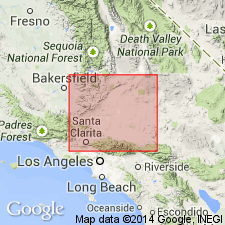
- Usage in publication:
-
- Bean Canyon formation
- Modifications:
-
- Named
- Dominant lithology:
-
- Schist
- Slate
- Quartzite
- Marble
- AAPG geologic province:
-
- Sierra Nevada province
Summary:
Named for exposures in Bean Canyon in northwest corner of Elizabeth Lake quad, Los Angeles and Kern Cos, CA. No stratotype designated. Composed of schists, slates, quartzites, marble, crystalline limestone, mica schist, amphibolite schist, and andalusite-cordierite schist, meta-andesite and meta-dacite. Thickness is 5000 feet. Probably in part Triassic and possibly in part Early Jurassic.
Source: GNU records (USGS DDS-6; Menlo GNULEX).

- Usage in publication:
-
- Bean Canyon formation*
- Modifications:
-
- Age modified
- AAPG geologic province:
-
- Sierra Nevada province
Summary:
Adopted as Bean Canyon formation. [No stratotype designated] Composed of dark-gray to nearly black fine crystalline platy rocks referred to as schists in report. Average grain-size <1/2 mm; rocks characterized by faint to conspicuous bedding. Schists consist of biotite, muscovite, quartz, plagioclase, and hornblende; contains some aluminum silicates. Quartzite is light-gray to tan, massive to faintly laminated, very fine grained (in Bean Canyon). Carbonates are limestone partially recrystallized to marble; grain-size range <1 mm to >5 mm. Contains some meta-basalt and meta-andesite. Assigned to late Paleozoic(?) based on lithologic and stratigraphic relations.
Source: GNU records (USGS DDS-6; Menlo GNULEX).

- Usage in publication:
-
- Bean Canyon formation*
- Modifications:
-
- Overview
- AAPG geologic province:
-
- Sierra Nevada province
Summary:
Type section designated as pendant in Bean Canyon, Tehachapi Mountains, Willow Springs 15' quad, Kern and Los Angeles Cos, CA. Is Paleozoic(?).
Source: GNU records (USGS DDS-6; Menlo GNULEX).

- Usage in publication:
-
- Bean Canyon Formation*
- Modifications:
-
- Age modified
- AAPG geologic province:
-
- Sierra Nevada province
Summary:
Age of Bean Canyon Formation considered to be Jurassic based on Rb/Sr age determinations averaging 150 Ma. This represents the age of volcanism (not the metamorphic homogenization of unit's rocks).
Source: GNU records (USGS DDS-6; Menlo GNULEX).
For more information, please contact Nancy Stamm, Geologic Names Committee Secretary.
Asterisk (*) indicates published by U.S. Geological Survey authors.
"No current usage" (†) implies that a name has been abandoned or has fallen into disuse. Former usage and, if known, replacement name given in parentheses ( ).
Slash (/) indicates name conflicts with nomenclatural guidelines (CSN, 1933; ACSN, 1961, 1970; NACSN, 1983, 2005, 2021). May be explained within brackets ([ ]).

